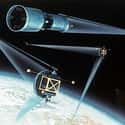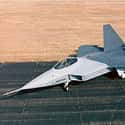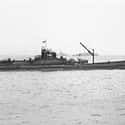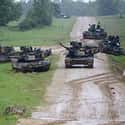-
(#1) Horten HO 229 'Bat'
No, that's not a B-2 Spirit stealth bomber - it's the German wonder weapon that inspired it. The "Bat" wasn't just incredibly fast and futuristic - it was the world's first purpose-built stealth aircraft. Most historians agree that the conflict could have gone very differently if the "Bat" had actually entered service earlier, not least of which because of its planned big brother.
The "Amerikabomber" would have been capable of reaching New York or Washington from bases in Germany, slipping under our radar, dropping a few tons of explosive devices, and returning without refueling. The original "Bat," though, would have been more than sufficient to rain havoc all over Europe, Russia, and England with near impunity.
-
(#2) Excalibur Space Laser
Otherwise known as "the project that bankrupted the Soviet Union," this space laser was at the heart of the 1984 "Star Wars" program touted by Ronald Reagan. It harnesses the power of a small nuclear blast to create a concentrated dose of X-ray or infrared energy at the Earth. That might sound like a Doctor Evil doomsday device, but this laser was meant to prevent doomsday for the United States.
It was designed as part of a projectile defense system and would have been used to shoot down incoming ICBMs while they were near orbit themselves. Technical problems, as well as the inability to target multiple warheads, kept this one from becoming a reality, but we could easily do it with modern technology. The air force is already working with airplane-mounted laser cannons to do exactly the same thing.
-
(#3) F-22 Raptor
The $450 million machine that is the F-22 Raptor has never once in its 25-year history fired a shot in anger. The world's first fifth-generation fighter has yet to find a target deserving of risking its expensive hide, especially since the Soviet Union collapsed. True, there are other fifth-gen fighters out there, but they're all still playing catch-up to the F-22 in terms of design and performance.
Lockheed won't be making any new F-22s for the foreseeable future. You could call that a shame, but as long as we're not using it, that means we're not at war with anyone dangerous enough.
-
(#4) XB-70 Valkyrie
Back in the 1960s, the Air Force was in the market for a B-52 replacement capable of penetrating deep into enemy airspace without getting shot down by interceptors. The Valkyrie would have used a unique compression lift body and tons of power to sustain Mach 3 at 70,000 feet. Its frontal view would have also made it difficult to spot on the radar in time to scramble fighters.
Apart from massive budget over-runs and a new focus on slimming down the military, the Valkyrie was ultimately done in by the newest generation of ultra-fast surface-to-air projectiles, which rendered the Valkyrie's speed of little use.
-
(#5) SLAM
Regular ICBMs have one major problem: they're easy to detect once launched, and leave the enemy plenty of time to shoot back. Any launch would essentially leave those who initiated the launch vulnerable, which is exactly what kept either side of the Cold War from firing. The SLAM (Supersonic Low Altitude Missile) would have gotten around that by flying at Mach 4 - below the enemy radar - by using its nuclear-powered jet engine to travel while irradiating everything it flew over. Essentially, it could level buildings with the sheer force of its supersonic shockwave.
The SLAM's ability to strike without warning would have undone the mutually assured destruction policy, and almost inevitably driven the world toward annihilation. Rather than a nuclear deterrent, the SLAM was a nuclear provocation - which is the primary reason it never (officially) entered service.
-
(#6) Lun-class ekranoplan
- Aircraft model
When it was first spotted by aerial surveillance, intelligence personnel believed "The Caspian Sea Monster" to be an unfinished high-altitude bomber with missing wings. But the Russian Ekranoplane "ground effect" sea skimmer was as fully functional as the Death Star. Like the SLAM, this nuclear bomber was designed to fly under the radar and deliver its massive, 100-ton payload of projectiles before the US Strategic Command had the chance to respond. That's the stealth and hitting power of a large nuclear submarine, with the speed of a jet airliner.
Ekranoplans don't actually "fly" - they're "ground effect" vehicles, riding on a cushion of compressed air trapped between the ground and their stubby wings. The Russian navy actually did use it through the 1990s as a transport vessel. Good thing for us, since a single ekranoplan would have carried more than enough nuclear ordinance to destroy every major city on the East Coast.
-
(#7) Japanese I-400 Aircraft-Carrying Submarine
The I-400 is not the only submarine ever to carry aircraft inside, but it was the first. This secret advantage of the Japanese navy in WWII was originally conceived by Admiral Yamamoto, who saw this stealth machine as Japan's only hope of hitting the United States or the Panama Canal.
It carried three Seiran planes armed with either incendiary devices or anti-ship projectiles and used a unique side-by-side double hull to keep from tipping over with the weight of the aircraft hangar on top.
-
(#8) Boeing-Sikorsky RAH-66 Comanche
- Attack helicopter
In 1983, engineers at Boeing-Sikorsky began development of the RAH-66 Comanche as a means to replace Vietnam-era helicopters. The Comanche boasted some pretty bold features that would have made it an impressive machine had it came to be. With a body composed out of radar-absorbing material, the Comanche was 43 feet long and could fly up to 201 miles per hour. It also had state of the art navigation systems and the capacity to carry up to 12 stinger projectiles.
So, what happened? A string of bureaucratic nightmares slowed down production over the years, eventually leading to the project being altogether abandoned after the government poured $7 billion into the machine. It took six years for the army to issue a Request for Proposals and then an additional three years to draft a development contract. Boeing-Sikorski took an additional nine years to even begin the manufacturing phase in 2000. While the company produced two prototypes in the following two years, the government axed the project before mass production could begin.
Why did the government shut things down when the company was finally ready to mass produce the Comanche? The process took so long - as is typical when dealing with massive bureaucracies such as the government, private companies, and the US Army - that things had changed significantly. Since the project's original inception, the army's needs had evolved. The RAH-66 Comanche was simply no longer what the government wanted.
-
(#9) Space Marines (SUSTAIN)
Project Hot Eagle was first proposed in 2002 as a variation on Space Ship One, a sub-orbital, air-launched spaceplane. The "Small Unit Space Transport and Insertion" (SUSTAIN) orbiter and its 13 space marines would be carried to high altitude on the belly of an even more bizarre-looking "mother ship" called "White Knight."
It would use its rocket booster to fly into low orbit. There, it could either hang out for a few hours awaiting the right time to strike or fly to the other side of the planet in less than an hour.
-
(#10) Tsar Bomba Hydrogen Device
How does one describe the most powerful man-made explosion in history - Russia's 50 megaton "Tsar Bomba"? All right, imagine a piece of the Sun about 2.2 miles in diameter suddenly appearing overhead. Now, imagine that 2-mile fusion fireball (itself bigger than the whole blast radius of "Little Boy") suddenly explodes, releasing all of its energy and simply vaporizing everything in a 20-mile radius. That's the entire city of London, turned into ash.
Everything within 50 miles perishes within hours, and within 100 miles a couple of days later. The mushroom cloud could be seen from 100 miles away, and the fallout could spread from New York to Colorado. The Tsar Bomba was never so much a weapon as it was a statement to the West: Beware the power of Mother Russia.
-
(#11) Project X-Ray
Project X-Ray seemed like an out-there idea, but the "Bat Bomb" (BB) had the potential to cause far more devastation than the atomic devices dropped on Japan. The BB contained hundreds of bats harvested from New Mexico, each one laden with a napalm-like incendiary device. The plan was to release the bats at dawn over Japanese cities, which were made almost entirely of wood and paper.
The bats would disperse up to 40 miles away and roost under the eaves of Japanese buildings. A few hours later, the devices would go off, setting huge swaths of Japan ablaze. Testing showed the BB to be incredibly effective, but the device was conceived too late in the conflict to see action before "Little Boy" and "Fat Man" dropped.
-
(#12) XM29 OICW
Standing for "Objective Individual Combat Weapon," the XM29 OICW was part of an endeavor to improve on existing combat devices. The machine looked like something out of a futuristic war videogame. In addition to having all the capabilities of a standard assault rifle, it included a semiautomatic six-round grenade launcher.
The XM29 OICW could also be taken apart and used as two separate entities, if ever necessary on the battlefield. However, the main drawback was that it was extremely bulky and difficult to handle. Operations for XM29 OICW have since been shut down.
-
(#13) Boeing YAL-1
- Aircraft model
Dating back to the Reagan years, the Boeing YAL-1 was part of the Airborne Laser program. Billions were spent on the machine, which was meant to be a massive futuristic machine that could shoot down ballistic projectiles using lasers. However, the machine proved a failure for a variety of reasons.
First, the lasers were not strong enough to shoot down enemy projectiles without orbiting dangerously close. Second, even if this could be corrected, the machine was extremely large. The army envisioned a fleet of Boeing YAL-1 aircrafts orbiting near enemy countries, but this would have been astronomically expensive. In the end, the Boeing YAL-1 became one of many that were too ineffective and expensive for the government to sustain.
-
(#14) Hiller VZ-1 Pawnee
- Aircraft model
Charles Zimmerman, a United States scientist, determined a helicopter rotor could be placed below a vehicle instead of above and still work just as well. After Zimmerman created one device that flew successfully, the Hiller Company set to work building the VZ-1 Pawnee. The US Navy saw some potential in the VZ-1 Pawnee as an armament in 1953 and awarded the company a contract to develop the machine further. This essentially meant soldiers could move the device by shifting their bodies. While the Pawnee saw some success, all three prototypes ultimately failed.
The VZ-1 Pawnee was meant to operate using something called "kinesthetic control." This essentially meant that soldiers operated the machines via maneuvering their bodies in the direction they wanted to move. The Hiller company ended up creating three different prototypes. The first two flew successfully via kinesthetic control, but the third was too big to be steered in such a fashion and relied on helicopter-type controls.
While the VZ-1 Pawnee helped further develop knowledge of aerodynamics, the project was ultimately abandoned. The machines were fairly slow, heavy, and clunky. They were also quite delicate and all this made them ineffective for the battlefield.
-
(#15) 2,000 M1 Abrams Tanks
America has a government program known as "The Military Industrial Complex," and that complex needs something to do whether the military needs it or not. Case in point, the Abrams tank, assembled in Lima, Ohio. After "contributing" $5.3 million to the re-election campaigns of House Armed Services Committee Member Hank Johnson (D-GA) and several other members of defense appropriation subcommittees, manufacturer General Dynamics got a $3 billion contract for 2,000 tanks that the Pentagon explicitly said it didn't need or want. Not just because it had enough tanks, either.
The Abrams, with its flat bottom, has proven very vulnerable to the mines and IEDs typically employed in the middle east, essentially rendering these incredible tools utterly useless. The Pentagon literally would have been better off spending $3 billion on horses and muskets. So, now we've got 2,000 brand new, useless tanks sitting in the desert in the American West, and that great social welfare program known as the Military Industrial Complex rolls on another day.
-
(#16) Gyrojet Handguns
A creative and futuristic firearm, the Gyrojet Handgun's main drawback was that it was utterly ineffective. Instead of pressurized gas, Gyrojets used rocket fuel to launch bullets. What was the purpose of this? Using rocket fuel over gas made the tool significantly lighter. The drawback, however, was that rocket fuel was grossly ineffective at powering bullets and the guns were completely useless at close range due to their slow momentum.
The company that produced the Gyrojet quickly went out of business.
New Random Displays Display All By Ranking
About This Tool
Our data comes from Ranker, If you want to participate in the ranking of items displayed on this page, please click here.
















